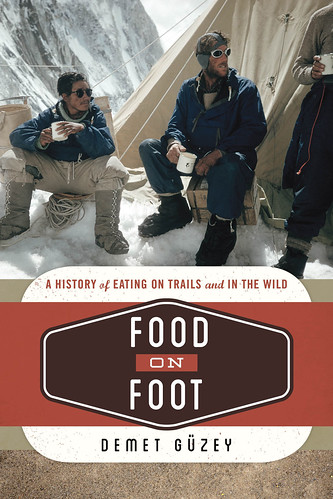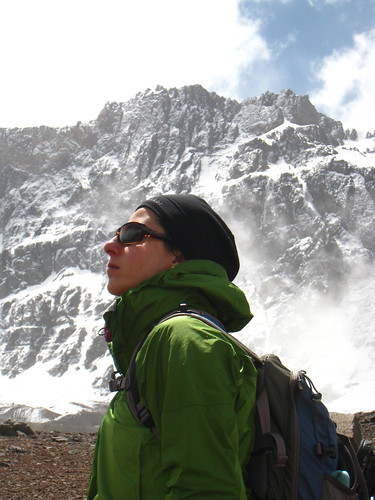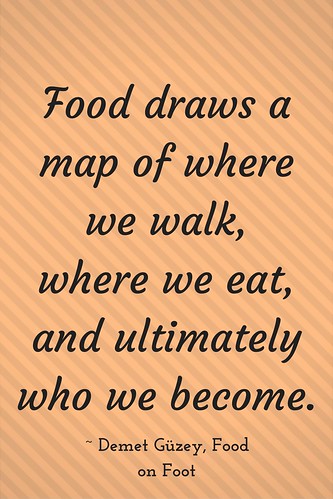I have found THE MOST FASCINATING book on eating outdoors. And I will tell you that once I started the book, I could not put it down (hello, 5am bedtime), and I have recommended it to all my friends who hike, meander, and eat in the wild. It has inspired me to look at being outside differently, and taught me much about food, walking and hiking, history, and culture.

World traveler, mountain climbing enthusiast, and scholar Demet Güzey introduces readers to the vital connection between food and human expedition in Food on Foot, the next installment in the Food on the Go series from Rowman & Littlefield. From pilgrims to pioneers, soldiers to explorers, the only limit to humanity's reach is the food they can find along the way, and Güzey examines the myriad ways we have approached this problem over the centuries and across landscapes.
Demet Güzey, PhD, is a writer and lecturer of food and culture with a passion for trekking in high mountains. She has published numerous articles in academic journals and magazines, ranging from Food Biophysics to Gastronomica, and climbed some grand mountains, such as Mont Blanc and Mount Ararat. She's an excellent writer, bringing joy to eating, taking us hiking and climbing throughout history, and cleverly drawing correlations between chuck wagons and food trucks, pilgrimages and the role of food in them, and the various ways to make coffee (!) outdoors. If you're ever in Verona, check out her website for dates for food walks (YAY!).
I love how she compares food across cultures - I have many post-it notes in the book! Here are two of my favorite passages:
"...sometimes food travels on foot, too, and stays where it is welcomed."
"Food on the street connects our body, mind, and the place to experience the world through our body and our body through the world. While we walk, our mind engages with our body and the place. We know the place through our body. While we eat, the engagement is strengthened. Food creates memorable experiences, also in the wilderness of the cities, perhaps not as in survival stories in historic expeditions or spiritual scarifies as in pilgrimage trails, but it marks nonetheless our personal geography. It draws a map of where we walk, where we eat, and ultimately who we become."
From tinned foods to foraging in the arctic wilderness, worm-infested hardtack to palate-dulling army rations, loss of appetite in high altitudes to champagne and caviar at base camps, Güzey gives a thoroughly researched and insightful account of how we manage food on foot, and how disaster strikes when we fail to manage it well.
Chapters include:
Food on Trails
Walking in a New Continent
Mountain Expeditions
Desert Travel
Pilgrimage
Army Rations
Street Food
Firsthand accounts, authentic artifacts and photographs, expert opinions, and recipes reveal new perspectives on lesser known as well as more famous expeditions, such as the disastrous end of the Donner Party, the stranded men of Shackleton on Elephant Island, and the first successful summit of Mount Everest. An extensive bibliography, my favorite part of any book, provides ample opportunities for further reading.
I highly recommend this book to anyone who loves travel, eating, and especially eating outside, while on the move. It is an extraordinary read.
We were lucky enough to catch up with Dr. Güzey, and ask her about the book, inspiration, research, culture, and more. She also shares a recipe!

Please tell us about your new book, Food on Foot…
This is the first book that looks at historic and current expeditions on foot with a food focus. I researched letters, diaries, books, expedition reports and archival photographs to find out the role of food in journeys on foot. Eating on long journeys was often a matter of life or death. Food was not just a necessity but also a psychological support in difficult times. What explorers ate revealed their intentions, the times they lived in, and their cultural background. Nowadays when we think of expedition food we imagine freeze-dried meals and energy bars, but for early explorers options were limited. They had to carry regular foods or tinned army rations, or hunt and gather food along the way. Their food was often dull, sometimes infested and occasionally dangerous. Still, they all looked for comfort and familiarity away from home.
What inspired you to write this book?
I was inspired by my own travels in the mountains. The organization of food in these trips and the specific culture of preparing and eating it is very different than eating indoors. I wondered if we could define a food culture of explorers or a culture of the outdoors. I found that in some ways we can, because all explorers depend on the technology of their time and the use tools and techniques, which suits their environment. But the cuisine of explorers is also very different as it was defined by where they were going and what their intention was. For example, Victorian mountaineers took enough food and wine for a feast. Climbing mount Everest for the first time, however, required a careful combination of army meals at base camp and a “luxury box” with desirable foods like tinned fruits, cookies, cheese, jam or candy at higher altitude. In desert travels instead explorers ate what was suitable for that environment, like dates and coffee. Depending on geography and objectives, explorers either accepted their environment or tried to conquer it. This makes a very interesting contrast between the foods of different voyages.

We're all about the research - what were the challenges and joys of researching for your book?
The challenge was to decide what not to include. A journey on foot covers all geographies, nations and times. The joy was to talk to people with different expertise like archivists, historians, hikers, ultrarunners, and mountaineers. I learned so much from each person, while trying to find the common thread that links their stories together.
What might readers be surprised to learn about your research?
For my research on polar expeditions, I went to the Royal Geographical Society in London. In their archives, they had foods from arctic expeditions: a block of chocolate, a box of Bovril (meat extract), a box with edible lichen, which is a mix of algae and fungus found in nature. I could feel the hands of explorers on these boxes from early 1800s. It is fascinating to imagine how these foods survived. It’s like archeologists finding remnants of grains or fish sauce in ancient Roman sites. Physical evidence tells you so much more about the food they ate than what they wrote in their diaries. It brings you closer to feeling like you are with them in their journey. Of course I wasn’t allowed to touch these items. The archivist showed them to me holding them with white cotton gloves.
Culture plays an integral part of eating on foot - do you have any insights you discovered, while writing this book?
I discovered that explorers took their own culture in the food that they were carrying. This is the same for modern travellers. This familiarity of food brings comfort and pleasure away from home. For example while British mountaineers took Kendal mint cookies with them to the Alps, Russian mountaineers would take caviar to Everest base camp. Italian ultrarunners told me that they take parmigiano reggiano cheese and polenta with them. The first woman on Everest instead carried gyozas, seaweed, and rice cakes. These foods represent more than calories and weight. These foods are part of who these explorers are.
What's up next for you?
More mountains and more food. I am about to go to Nepal for a hiking trip in the Upper Mustand Region. Currently I am working on a book about the history of mustard. In this trip I might also have a chance to research the ancient tribe in Nepal who make mustard oil and use it for their tattoo rituals.
Is there anything else you'd like to share?
Trail mix is a universal snack on trails. It’s also called gorp in the United States, pink buggie in Canada, or scroggin in Australia and New Zealand. Scroggin was used as a snack by Australian bushwalkers, although there is an ongoing battle between New Zealand and Australia on who used the term first. Its name is said to come from the abbreviation of its main ingredients: sultanas, chocolate, raisins, orange rind, ginger, glucose (sugar), improvisation or imagination, and nuts.
Here is a recipe to try on your next hiking trip:
Scroggin
Ingredients (for 4 cups):
1/2 cup sultanas
1/2 cup chocolate chips
1/2 cup raisins
1/2 cup candied orange rind
1/2 cup crystallized ginger
1/2 cup roasted unsalted nuts
1/2 cup liquid glucose
1/2 cup any other seed or dried fruit
Directions:
Mix together all ingredients. Add other ingredients you like, as long as they are in lesser amounts.
Visit my website and say hello at demetguzey.com
Pin for later:

